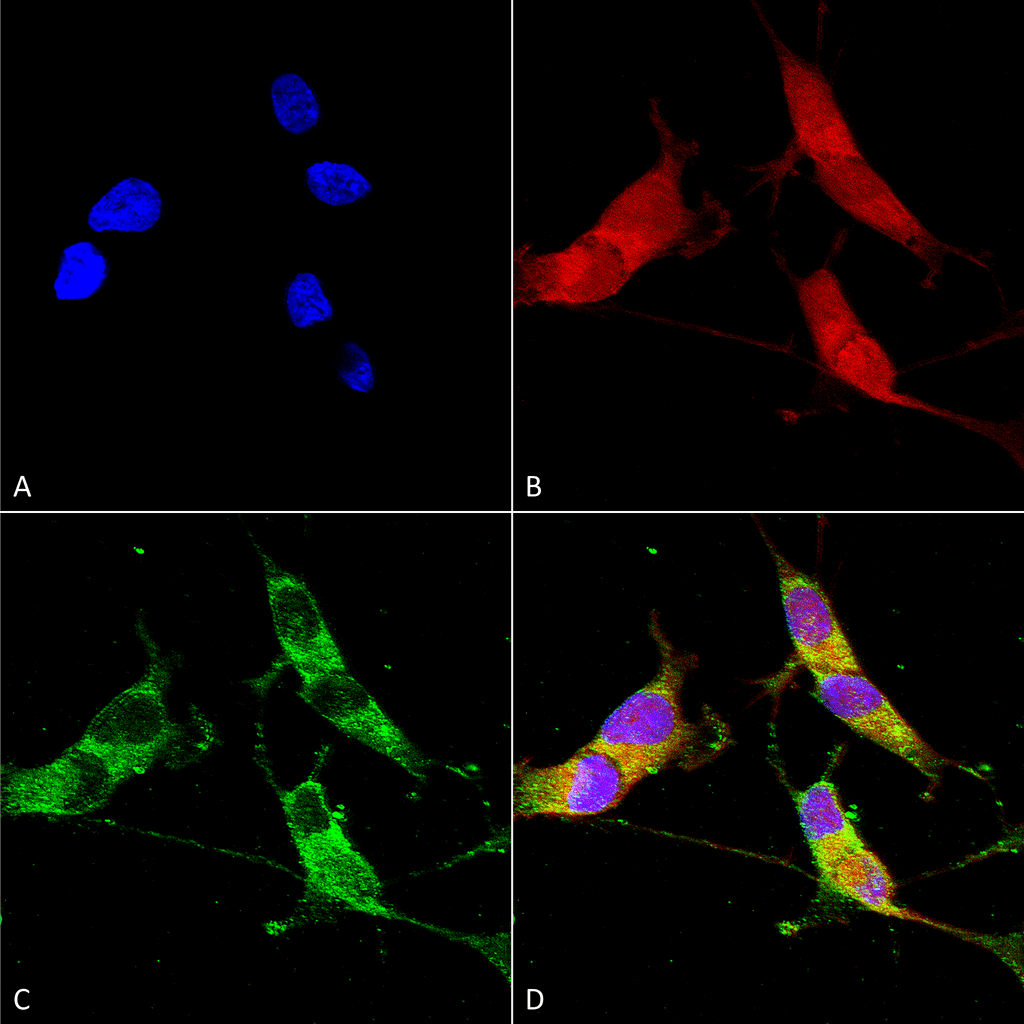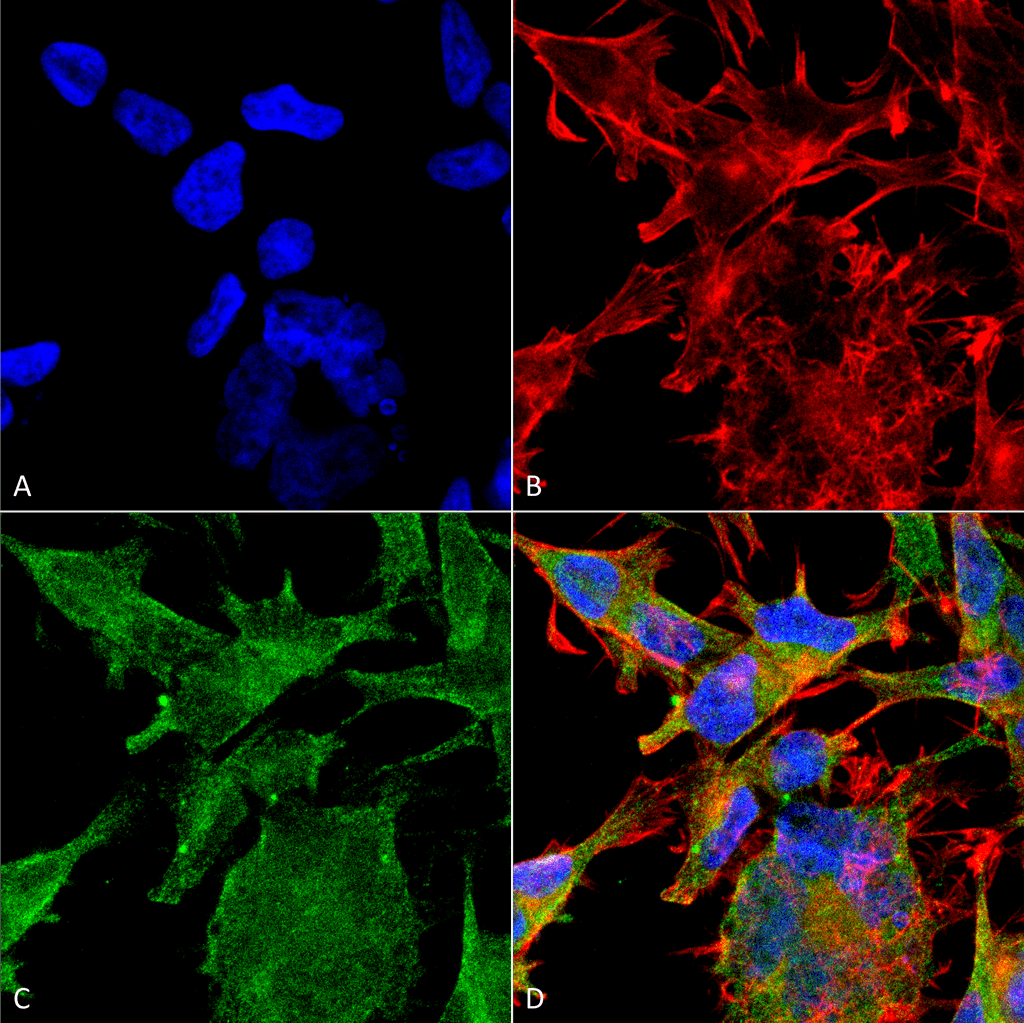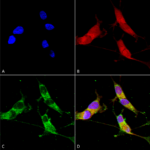Properties
| Storage Buffer | PBS pH7.4, 50% glycerol, 0.09% sodium azide *Storage buffer may change when conjugated |
| Storage Temperature | -20ºC, Conjugated antibodies should be stored according to the product label |
| Shipping Temperature | Blue Ice or 4ºC |
| Purification | Protein G Purified |
| Clonality | Monoclonal |
| Clone Number | N29/29 (Formerly sold as S29-29) |
| Isotype | IgG1 |
| Specificity | Detects ~60kDa. |
| Cite This Product | StressMarq Biosciences Cat# SMC-395, RRID: AB_11229706 |
| Certificate of Analysis | 1 µg/ml of SMC-395 was sufficient for detection of VGLut2 in 20 µg of rat brain lysate by colorimetric immunoblot analysis using goat anti-mouse IgG:HRP as the secondary antibody. |
Biological Description
| Alternative Names | Differentiation associated BNPI Antibody, DNPI Antibody, SLC17A6 Antibody, Solute carrier family 17 member 6 Antibody, Vesicular glutamate transporter 2 Antibody, Differentiation associated Na dependent inorganic phosphate cotransporter Antibody, Solute carrier family 17 (Sodium dependent inorganic phosphate cotransporter) member 6 Antibody, Differentiation associated Na(+) dependent inorganic phosphate cotransporter Antibody, Differentiation-associated Na(+)-dependent inorganic phosphate cotransporter Antibody, Sodium dependent inorganic phosphate cotransporter Antibody |
| Research Areas | Cell Markers, Cell Signaling, Neuron Markers, Neuroscience, Neurotransmitter Transporters, Presynaptic Markers, Pumps/Transporters |
| Cellular Localization | Cell Junction, Cytoplasmic Vesicle, Membrane, Secretory vesicle, Synapse, Synaptic vesicle membrane |
| Accession Number | NP_445879.1 |
| Gene ID | 84487 |
| Swiss Prot | Q9JI12 |
| Scientific Background | The ATP-dependent, chloride-sensitive vesicular glutamate transporters (VGLUT) include BNPI (VGLUT1), VGLUT2 (DNPI) and VGLUT3. The brain expresses BNPI (brain specific Na+-dependent inorganic phosphate (Pi) cotransporter) and VGLUT2 in a complementary fashion. The telencephalic regions express BNPI, whereas the lower brainstem and diencephalic regions express VLGUT2. Rat pinealocytes express both BNPI and VGLUT2. The striatum, hippocampus, cerebral cortex and raphe nuclei express VGLUT3 in a small number of neurons. Pancreatic α and β cells express BNPI and VGLUT2 in response to glucose concentrations. Human VGLUT3 shares a 72% sequence homology with VLGUT2 and BNPI. |
| References |
1. Aihara Y., et al. (2000) J Neurochem. 74: 2622-2625. 2. Kaneko T., and Fujiyama F. (2002) Neurosci Res. 42: 243-250. 3. Gras C., et al. (2002) J Neurosci. 22: 5442-5451. 4. Takamori S., Malherbe P., Broger C., and Jahn R. (2002) EMBO Rep. 3: 798-803. 5. Morimoto R., Hayashi M., Yatsushiro S., Otsuka M., Yamamoto A., and Moriyama Y. (2003) J Neurochem. 84: 382-391. 6. Bai L., Zhang X., and Ghishan F.K. (2003) Am. J. Physiol. Gastrointest. Liver Physiol. 284: G808-814. |
Product Images

Immunocytochemistry/Immunofluorescence analysis using Mouse Anti-VGLUT2 Monoclonal Antibody, Clone N29/29 (SMC-395). Tissue: Neuroblastoma cells (SH-SY5Y). Species: Human. Fixation: 4% PFA for 15 min. Primary Antibody: Mouse Anti-VGLUT2 Monoclonal Antibody (SMC-395) at 1:50 for overnight at 4°C with slow rocking. Secondary Antibody: AlexaFluor 488 at 1:1000 for 1 hour at RT. Counterstain: Phalloidin-iFluor 647 (red) F-Actin stain; Hoechst (blue) nuclear stain at 1:800, 1.6mM for 20 min at RT. (A) Hoechst (blue) nuclear stain. (B) Phalloidin-iFluor 647 (red) F-Actin stain. (C) VGLUT2 Antibody (D) Composite.

Immunocytochemistry/Immunofluorescence analysis using Mouse Anti-VGLUT2 Monoclonal Antibody, Clone N29/29 (SMC-395). Tissue: Neuroblastoma cell line (SK-N-BE). Species: Human. Fixation: 4% Formaldehyde for 15 min at RT. Primary Antibody: Mouse Anti-VGLUT2 Monoclonal Antibody (SMC-395) at 1:100 for 60 min at RT. Secondary Antibody: Goat Anti-Mouse ATTO 488 at 1:200 for 60 min at RT. Counterstain: Phalloidin Texas Red F-Actin stain; DAPI (blue) nuclear stain at 1:1000, 1:5000 for 60 min at RT, 5 min at RT. Localization: Cytoplasmic Vesicle, Secretory Vesicle, Synaptic Vesicle Membrane, Membrane, Cell Junction, Synapse. Magnification: 60X. (A) DAPI (blue) nuclear stain. (B) Phalloidin Texas Red F-Actin stain. (C) VGLUT2 Antibody. (D) Composite.


![Mouse Anti-VGLUT2 Antibody [N29/29] used in Western Blot (WB) on Rat brain membrane lysate (SMC-395)](https://www.stressmarq.com/wp-content/uploads/SMC-395_VGLUT2_Antibody_N29-29_WB_Rat_brain-membrane-lysate_1.png)




















Reviews
There are no reviews yet.